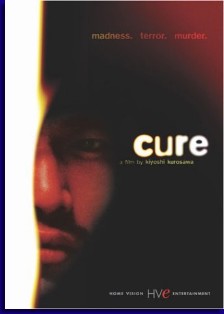

Reviewed by
Christopher Armstead


A man with no history of violence bludgeons a prostitute to death with a lead pipe. Another man slits the throat of his beloved wife. A police office officer shoots his partner in the head. There are more of these strange murders happening in Tokyo, baffling the detectives in charge of the case. Each murderer carves an X across the chest of their victims, which would appear to be the sign of a serial killer, though each of the perpetrators is a different person. Equally puzzling is that each one is completely conscious of their crimes; they just don’t understand why they did them.
Thus we have Kiyoshi
Kurosawa’s Cure. Horror Movies from the East (Far
East that is, not like Jersey or something.) are
certainly different from our horror films in the west.
Absolutely
no reliance on cheap jolts like cats jumping from a
window without warning, or slow building music ending
with a blaring horn as a creaky door flies open. No, Asian
Filmmakers tend to use mood and atmosphere, and in the
case of Cure, it’s extremely effective.
Detective Kenichi Takabe (Koji Yajusho) has found a common thread in each case in the form of Kunio Mamiya, (Masto Hagiwara), a spookily eerie young man who can’t remember who he is or where he’s from, but he seems to know a heck of a lot about everybody else. Detective Takabe is convinced that Mamiya is using hypnotism to convince these victims to kill each other. Takabe's own mental welfare is under seige. His wife has lost her short-term memory, which often causes to leave the apartment to go the grocery store or such, then wander the city for hours because she has forgotten

where the store is located and ultimately, where she lives. Takabe worries about this constantly, struggling against the need to have his beloved wife committed. Mamiya ‘s ability to manipulate these emotions places Takabe in a constant battle to control his sanity as well as prove that Mamiya is serial killer, though he has touched no one.
There is sense of
constant foreboding and impending doom in the
deliberate pace of Cure. Just as
Mamiya is hypnotically manipulating his prey,
Kurosawa is skillfully manipulating us, his
audience, to participate into Takabe’s slow descent
into madness.
Not that this is an easy film to watch. Some may
find it slow and detached. If you do make a connection to
the film you will probably find it uneasily
unsettling. Masto
Hagiwara as Mamiya is extremely effective as
soulless evil.
His motivation seeming to be simply because
he can. We
sometimes prefer easy answers to our questions, and
solid reasons why characters do what they do, and
this movie offers you none. As with
many Asian films, the ending is open ended, no neat
and tidy bows for us to take home. Draw you
own conclusions and chances are yours are probably
different from mine.
Simple enough, if you
like Japanese horror, you’ll probably like Cure. If your
tastes run along cats jumping out of windows, a
Friday the 13th anniversary edition
is being released soon. Pick it up.

